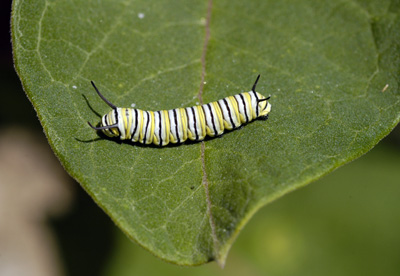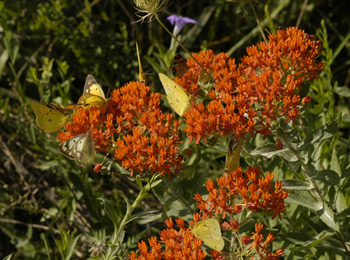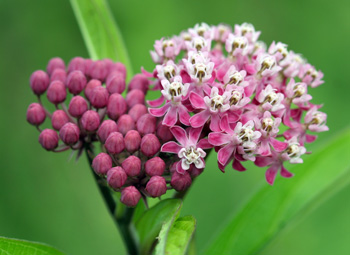
Growing milkweeds for monarch butterflies
DOWNLOADJune 10, 2016 - Duke Elsner, MSU Extension
The monarch butterfly is one of the most widely recognized butterflies in North America, well known for its spectacular migrations. The caterpillar stage feeds only on the leaves of plants in the milkweed family. In recent decades, the availability of milkweed for monarchs has greatly reduced because of changes in the way we use land from gardens and lawns on up to forests and fields. This has contributed to a severe decline in the population of this beautiful butterfly.
Anyone with a bit of garden space to spare can help the monarch population recover. Planting milkweeds on your property will provide food plants for monarch caterpillars and nectar sources for adult butterflies. In addition to supporting the monarch, milkweed species are important sources of nectar for dozens of other butterflies and numerous pollinating insects such as native bees and honey bees.

Monarch butterfly nectaring on common milkweed. Photo credit: Duke Elsner, MSU Extension
Which milkweeds to grow
There are over 100 milkweed species in the United States, but typically only a few species will be adapted to the climate and growing conditions in a particular area. Therefore it is important to choose the correct milkweed varieties to grow on your property. Some milkweeds can spread rapidly by means of underground rhizomes, so be cautious about planting these where space is limited or other plants may have trouble competing.

Monarch caterpillar on common milkweed. Photo credit: Duke Elsner, MSU Extension
Planting milkweeds
Milkweeds can be started from seeds or as young container plants. Older milkweed plants are very difficult to transplant, so Michigan State University Extension does not recommend this approach.
Milkweed seeds can be collected from existing plants or purchased from commercial suppliers. Seeds need a three-month period of exposure to cold (cold stratification), so it is a good practice to plant seeds in autumn. Container plants can be planted in spring, but it is advisable to wait until the threat of spring frosts has passed. View the statewide table for frost free dates in Michigan.
Commercially available milkweeds for Michigan | |||
|---|---|---|---|
|
Common name |
Scientific name |
Native range in Michigan |
Available as |
|
Common milkweed |
Asclepias syriaca |
Throughout |
Seed |
|
Butterfly milkweed |
A. tuberosa |
Throughout |
Container plants and seed |
|
Swamp milkweed |
A. incarnata |
Throughout |
Container plants and seed |
|
Whorled milkweed |
A. verticillata |
Southern Lower |
Seed |
|
Tall milkweed |
A. exaltata |
Throughout |
Container plants |
|
Prairie milkweed |
A. sullivantii |
Southern Lower |
Container plants |


Left, Butterfly milkweed with a bevy of butterflies. Right, Swamp milkweed flowers. Photo credits: Duke Elsner, MSU Extension (left; butterfly milkweed); David Cappaert, MSU, Bugwood.org (right; swamp milkweed).
More information on milkweeds and monarchs
- Gardening for Monarchs, Monarch Joint Venture
- Plant Milkweed for Monarchs, Monarch Joint Venture
- Monarch Watch Milkweed Market
- Common Milkweed, USDA Forest Service
- Butterfly Milkweed, USDA Forest Service
- Swamp Milkweed, USDA Forest Service
Print a PDF of this article: Growing milkweeds for monarch butterflies



 Print
Print Email
Email





